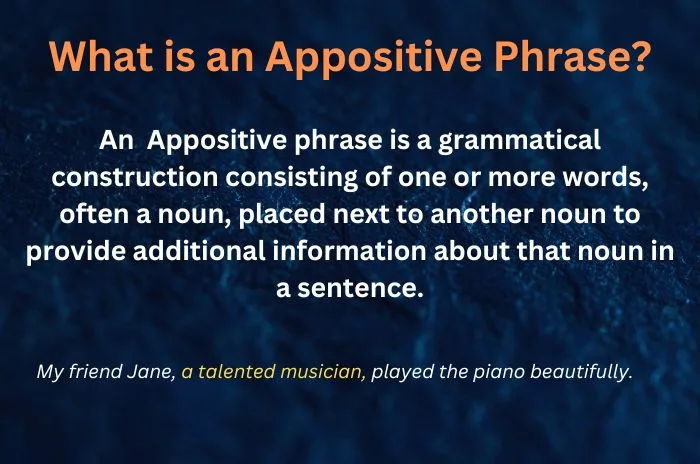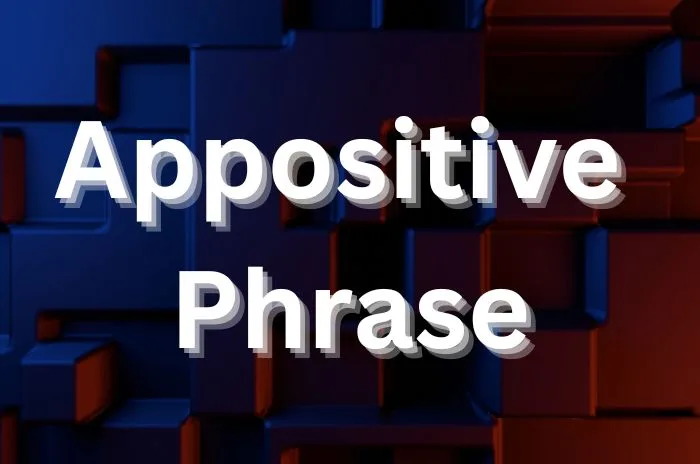What is an Appositive Phrase? How is it used and identified in a sentence and when should it be used?
This phrase is a grammatical construction consisting of one or more words, often a noun or noun phrase, placed next to another noun or pronoun to provide additional information, clarification, or identification about that noun or pronoun.
This post highlights definitions, examples, and tips for using this literary device effectively. Find out how to use them in sentences and find creative ways to make your prose shine.
What is an Appositive Phrase?
The phrase is a grammatical construction consisting of an affirmative and its modifier. An appositive is a noun or noun phrase that renames or describes another noun or noun phrase that immediately precedes it. The appositive and the noun it names are usually close to each other in a sentence. It helps to make the sentence more descriptive and precise.
These are used to add detail and clarity to sentences, making them a valuable tool in writing to provide additional context about a subject.
For example:
My friend Jane, a talented musician, played the piano beautifully.
In this sentence, “Jane” is the appositive that renames “my friend,” and “a talented musician” provides additional information about Jane.
It has two primary categories: restrictive and nonrestrictive.
Restrictive phrases, referred to as essential phrases, consist of words or phrases that offer vital information necessary to construct a complete sentence. These phrases do not require commas.
Nonrestrictive phrases, also known as nonessential phrases, pertain to information that is not essential to the sentence’s core meaning. These are typically set apart by comma

Appositive Phrase Examples With Answers
An appositive phrase is a group of words that replaces or explains the name of another noun or pronoun in a sentence. It is usually set off by a comma. Here are some examples:
1. My friend, a talented musician, played the Guitar at the concert.
In this sentence, “a talented musician” is an affirmative phrase that takes the place of “my friend”.
2. The city of London, called the City of Love, is a popular tourist destination.
In this sentence, “city of love” is an affirmative phrase that provides additional information about “the city of London”.
3. My father’s car, a sleek grey sedan, is parked on the street.
Here, “a sleek grey sedan” is an appropriate phrase to describe “my brother’s car”.
4. A masterpiece of modern art, this painting sold for millions at auction.
“A masterpiece of modern art” is a positive phrase that further describes the “painting”.
5. Jone’s dog, a lively Golden Retriever, loves to play.
In this sentence, “a lively golden retriever” is an affirmative phrase that provides more detail about “Jones’s dog.”
6. Our English teacher Mr.Simon gives challenging homework every day.
Our maths teacher” is an affirmative phrase identifying “Mr. Simon“.
7. The mountain, a high peak, is a challenging climb for experienced hikers.
“A high peak” is a positive phrase describing a “mountain”.
8. The author, a Pulitzer Prize winner, will speak at the library next week.
Here, “a Pulitzer Prize winner” is a positive phrase that adds information about the “author.”
9. Our neighbour, Mrs Sharma, is hosting a garden party this weekend.
Here “Mrs. Sharma” is the positive phrase identifying “our neighbor.”
10. The President, a charismatic and eloquent speaker, addressed the nation.
Here “A charismatic and eloquent speaker” describes “the president.”
Affirmative phrases help provide additional detail and context to a noun or pronoun in a sentence, making writing more descriptive and engaging.

Read Also: Accept Vs Except for A Comprehensive Guide 2023
FAQ
What is A phrase in apposition?
A phrase in apposition is a grammatical construction in which a noun phrase is placed next to another noun phrase to provide additional information about the second noun phrase.
What are the two appositive phrases?
Restrictive and non-restrictive.
What is an appositive clause?
An appositive clause is a group of words that provides additional information about a noun or pronoun in a sentence, often set off by commas.
How is appositive used in a sentence?
An appositive is used in a sentence to provide additional information about a noun by renaming it.
What is the difference between appositive and Opposition?
Opposition is the grammatical relationship between two elements placed side by side, while an appositive is a noun or noun phrase that explains another noun in the same sentence.
Conclusion
The above post “What is an Appositive Phrase” can significantly enhance your writing. These versatile grammatical tools add depth and clarity to your sentences, making your content more engaging and comprehensible. By incorporating appositive phrases effectively, you can elevate your writing and improve its overall quality.
